The conceptual lenses of evolution completely transform how we see the world.
For example, without thinking about things from an evolutionary perspective, a walk through my neighborhood on a morning in May is pleasant enough, but not particularly dramatic. Elm trees, oaks and maples stand along the boulevard, limbs stretched overhead to make the street a green tunnel, the blue sky barely visible beyond the canopy of leaves.
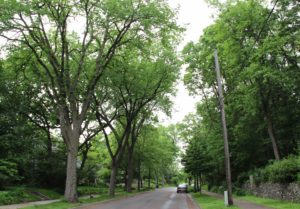
Honeybees and butterflies visit the irises blooming in the garden. A little black-capped chickadee perches for a moment on a branch above the birdhouse and opens his beak to sing his song, joining the chorus of that fills the morning air.
Looking at this peaceful scene through the lenses of evolution, though, reveals that this tiny little chickadee is a dinosaur. We know now that the dinosaurs didn’t disappear; in fact the number of living dinosaur species (10,000 or so) greatly exceeds the number of mammals (not quite 6,000). This chickadee, like all other birds, is a theropod dinosaur, distant kin to Tyrannosaurus rex. The more we learn about dinosaurs, the more we learn how much like birds they were. While it’s hard to be certain about the soft tissue, physiology and behavior of long extinct animals, various lines of evidence suggest that, like this chickadee, Tyrannosaurs was a feathered biped with a four-chambered heart, possibly with warm blood in its veins, and (perhaps) a devoted parent.
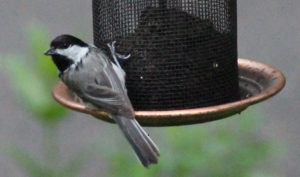
The song the chickadee is singing is no idle amusement to pass away the time. It is a matter of utmost importance to him. He sings to claim this territory as his own, to keep all rival males at bay. And why does he care so much this territory? Because this bit of yard and trees will be the home for him and his wife, the mate he seeks to woo with his song. The morning air resounds with the love songs of dinosaurs.
The flowers blooming in the garden and on the lawn are lovely in their own right. But viewing them through the lenses of evolution, we see that, like the songs of birds, they are all about sex. Each flower is a cunningly designed sex organ. The irises growing in the garden have large intricate blooms, with deep purple or yellow petals shading the male and female sex parts within: the female pistil, and the stalks of male stamens. Like the songs of birds, flowers are designed to attract mates. But flowers don’t have eyes, and they can’t move, so in order to mate, they lure other species to help them. While we humans find the vividly colored petals attractive, the iris is really aiming its message at the eyes of bees.
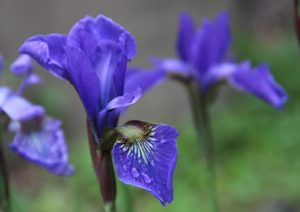
The bottom petal of the iris is an exquisitely designed landing platform for bees. A pattern of colors – likely including colors that bees but not humans can see, in the ultraviolet spectrum – guides the bees down a tunnel into the heart of the flower. There the iris provides the bee with a meal of nectar, while coating the bee with pollen as she sips her meal in the snug chamber. Each grain of pollen protects a cell that will give rise to two sperm cells. Dusted with flower sperm, the bee exists the chamber and flies off to another flower, playing its role in an interspecies ménage-a-trois.
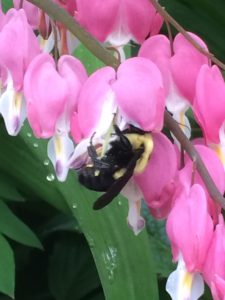
The elms, oaks and maples whose boughs shade the street in green light seem peaceful enough. But viewed through the lenses of evolution, we can see that these trees are fighting a long, slow battle. Each tree is growing as fast as it can to reach the sun. Each tree has many enemies: the caterpillars that eat the leaves; the Dutch elm disease that gnaws at their roots; the summer storms that break their limbs. But no enemy is a more bitter rival than its neighboring trees. Each tree is fighting a slow struggle to reach the sun first, to spread their limbs wide and cover their enemy trees in the darkness of their shade. And why do these trees care so much for the sun?
The sun is life, their source of energy. Each tree is a solar powered sugar factory, holding thousands of flexible green solar panels up to the sky. Shade is death. The tree must grow high above the neighboring trees to reach the sun.
And why must the trees make sugar? So they can make babies. These trees have spent the spring having sex and making babies. Unlike irises and dandelions, though, these trees don’t rely on other species to have sex for them. Instead, they have sex with the wind, releasing their pollen into the air. Not long ago, the greenish yellow dust of tree sperm covered every surface outside: the sidewalks, parked cars, porches, and grills. Now the world is covered with the resulting babies: tree embryos in tiny packages. Some of them have wings: the helicoptering seeds of maples, or the tiny flying discs of elms. Floating in the breeze, and choking the grill of the air conditioner, are the tiny fluffy seeds of cottonwood trees. These trees, growing to giant size along the Mississippi floodplain, make the tiniest seeds, each suspended by a parachute of fluff.

Year after year, each of these trees makes thousands or millions of seeds. And almost every single one of these seeds will die before it becomes a tree, eaten by birds or squirrels, washed down the gutter to the storm sewer, dissected by children curious about what’s inside a maple helicopter. A fortunate few will land on soil where they can take purchase and sprout – only to be plucked by weeding gardeners, or eaten by rabbits or deer. Only a tiny fraction of all this abundant mass of seeds will ever grow into trees big enough to make seeds of their own.
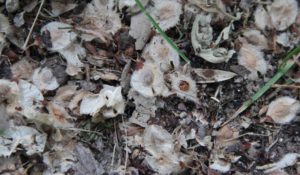
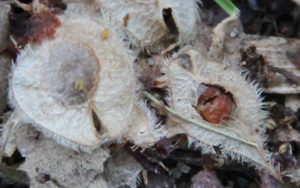
Viewing the world through the lenses of evolution help us see that what seems to be a quiet city street is actually an unfolding drama of sex and violence: seductive flowers, battling trees, and dinosaur love songs.
